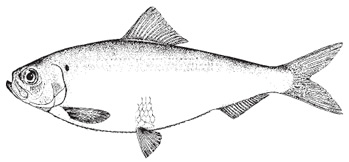Habitat, biology, and fisheries
Euryhaline, entering brackish and fresh waters, anadromous, schooling. Undertakes seasonal migrations, possibly in conjunction with changing patterns of water temperature; generally inshore and northward during spring from overwintering areas. Adults migrate up rivers and even small streams, spawning in lakes and quiet stretches of rivers; landlocked populations also ascend affluent rivers and streams; juveniles descend in summer and autumn, or even as late as November or December. Spawns in March in the Chesapeake Bay area, late April or May in Maine and in Canada. Estimated fecundity 60,000 to 467,000 eggs/female. Eggs semi-demersal, pink, 0.80 to 1.27 mm.Light levels play major role in daily behaviour; light sensitive; tend to be found in water column rather than at surface during daylight hours.May undertake vertical migrations corresponding with diel movements of zooplankton. Primarily particulate-feeding planktivore, consuming wide variety of zooplankton (euphausiids, copepods, amphipods, mysids, ostracods); with increasing size, diet switches from micro- to macrozooplankton; adults feed on shrimps and small fishes, juveniles on diatoms, copepods, and ostracods. Probably not always distinguished from A. aestivalis. Taken in a variety of gears in inshore waters and also in trawls offshore. In the 1970s and 1980s, this species contributed the largest landings of North American shads, but more recent catches have been considerably less. Marketed fresh, salted, frozen, and smoked. |
